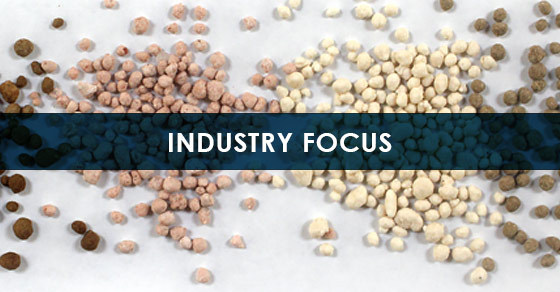Potash fertilizer production has been on a steady growth path as requirements for the material rise in the face of global food demand. Producers the world over are working to bring additional production online, particularly when it comes to new and novel sources of the potassium-bearing mineral. Combined with the fact that growers have increasingly higher expectations of their fertilizer products, it’s easy to see why potash fertilizer development work has been on the rise.
The FEECO Innovation Center has become a hub for potash producers looking to confirm feasibility of their intended process, gather data necessary for scale up, improve their existing products, and so much more. Testing capabilities center around potash drying, coating, and wet granulation (pelletizing).
What follows is a look at the testing capabilities and process development journey that happens in the FEECO Innovation Center.
When Potash Testing is Helpful
Testing in a facility such as the FEECO Innovation Center opens a world of opportunity to potash producers. Through testing, potash producers can do all of the following, without making a substantial investment or affecting their existing production facility:
Evaluate Changes to an Existing Production Line
As the potash industry evolves, producers must evolve with it in order to stay competitive. This often means changes to the production plant, whether that be an increase in capacity, the addition of a new treatment, or otherwise.
Further, as technology improves and producers look at how they can minimize costs, process efficiency has become a top priority, leading many producers to analyze efficiency at every level of production.
Evaluating changes to an existing production line can be costly, impacting production schedules, product quality, and more. This ultimately equates to significant risk. The ability to simulate production conditions in a test facility mitigates this risk and gives producers a safe outlet for evaluating their intended changes.
Develop a Process Around a New or Novel Source of Potash
As the potash market booms, producers are constantly assessing new sources and types of potash for commercialization.
As an example, potassium sulfate, or SOP, along with langbeinite or SOPM, has become a popular alternative to potassium chloride, or MOP – the traditional source of potash fertilizer. Because SOP behaves differently than MOP, producers are finding they have to test SOP fertilizer production thoroughly to develop a process that allows them to achieve the parameters they’re looking for in an end product.
Improve an Existing Product
Along the same lines, producers are also looking to improve their existing products. This often involves testing new formulations, trialing new binders, or changing their production line in an effort to improve handling characteristics, product performance, or other aspects of the product.
Here again, a test facility is invaluable to evaluating various process and product configurations. It also gives producers the opportunity to produce various test samples for field trials.
Types of Testing Available for Potash
The Innovation Center is equipped with the expertise and equipment needed to test the various aspects of the potash fertilizer production process. Various sources and compounds of potash can be tested.
Commonly Tested Potash Materials:
- Potassium chloride/KCl/MOP
- Potassium sulfate/K2SO4/SOP
- Potassium magnesium sulfate/2MGSO4/SOPM
- Langbeinite
- Potassium nitrate(KNO3)
- Potassium Carbonate (K2CO3)
- Potassium Thiosulfate (K2S2O3)
Testing capabilities available in the Innovation Center include:
Drying
Potash dryer testing is available, both as part of product finishing, and in preparing potash for use as a feedstock in another process. The following equipment is available for testing potash drying:
- Continuous Rotary Dryer
- Flight (Lifter) Simulator
Coating
Coating has become a popular way to reduce potash caking and improve product handling qualities, as well as product performance. The Innovation Center is equipped with a continuous pilot coating drum flexible in design for testing purposes.
Glazing
Glazing is often used as a way to reduce potash attrition when the product has been agglomerated via roll compaction. The following equipment may be used to test the potash glazing process:
- Continuous Rotary Dryer/Rotary Drum
- Continuous Mixer (Paddle Mixer/Pug Mill)
Pelletizing
Pelletizing, a type of agitation agglomeration, is becoming an increasingly popular way to process potash into a premium fertilizer product. Equipment available for testing the pelletizing process in the Innovation Center includes:
- Batch Disc Pelletizer
- Batch Pin Mixer
- Continuous Disc Pelletizer
- Continuous Pugmill Mixer (Paddle Mixer/Pug Mill)
- Continuous Pin Mixer
- Continuous Granulation Drum
Target Product/Material Characteristics
Throughout testing, modifications can be made to process and feedstock parameters to target specific qualities in the end product, a key aspect of developing a fertilizer. Characteristics commonly targeted through testing include:
- Attrition
- Bulk Density
- Coating Uniformity
- Compression
- Crush Strength/Hardness
- Flowability
- Granulometric Spread Index (GSI)
- Green/Wet Strength
- Hygroscopicity
- Moisture Content
- Particle Size Distribution
- Size Guide Number (SGN)
- Solubility
- Surface Area to Volume (SA:V)
- Temperature
- Uniformity Index
Conclusion
While process development has always been an important part of the potash industry, it is even more critical now, helping producers to make the products their customers demand and keep up with the changing agriculture industry.
The world’s top potash producers have come to rely on the FEECO Innovation Center for the best in comprehensive testing and development capabilities around drying, coating, glazing, and pelletizing potash. For more information on the FEECO Innovation Center, or to set up a test, contact us today!


